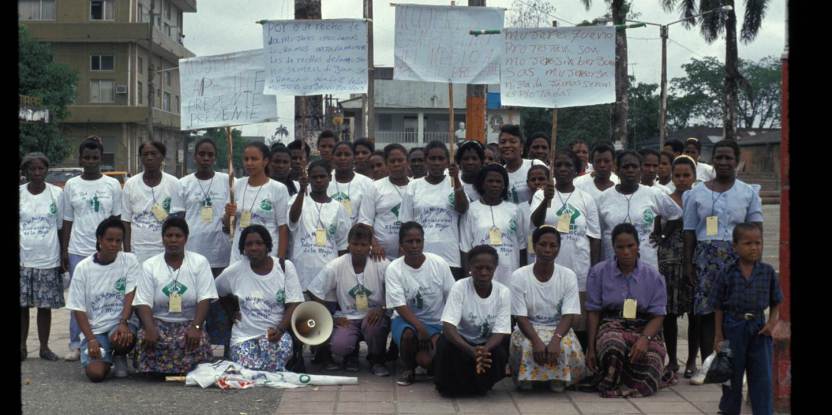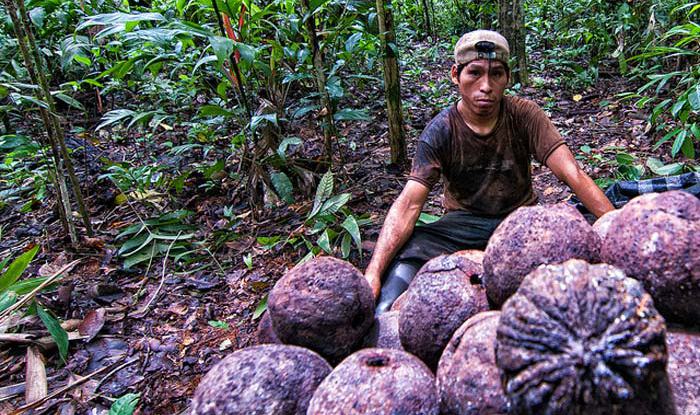
The Colombian Pacific region is a rich and complex landscape—ecologically, economically, politically and culturally. Rapid and often controversial changes in the past two decades have displaced millions of people and continue to pose severe threats to the landscapes on which local livelihoods depend. There, as elsewhere, women play a key role in managing forests for food. The density of forest cover in the Chocó region of the Pacific lowlands of Colombia (and their importance in local livelihoods) makes it a natural site to explore the gender dynamics of forest-based food security.
Late last year I returned to the Colombia’s Pacific coast to follow up on my long-term research on black women’s activism. When I landed in Cali, a dozen women from La Toma, a nearby town, had just begun marching to Bogotá in protest against illegal gold mining on their lands, which is contaminating the local Ovejas River and surrounding landscapes and affecting local livelihoods.
The women from La Toma are just a small group of the many Afro-Colombian women who are active in environmental protests and efforts to promote sustainable alternatives.
The story of the La Toma women is similar to those of many communities across Latin America and Asia. What is particularly ironic about the Afro-Colombian struggles is that they continue despite legal recognition of land rights and the sound science in support of traditional management of forest resources. Local dynamics are connected in complex and contradictory ways to broader national and global political economic processes.
So, how women use and manage resources and how changes in gender divisions of labor impact forests and food is dependent not just on local dynamics but also on external interventions and how they interact with local dynamics. Put differently, context matters—a lot, and in contingent ways. This is a lesson I learned two decades ago when I first went to the Pacific lowlands as a biologist to study collective land use and territorial rights among Afro-Colombian communities.
It is a lesson worth remembering and bears retelling.
THE CHOCÓ
Part of the Chocó biogeographic region, the Colombian Pacific region extends 1,300 kilometers from the southern tip of the Darien Peninsula in Panama to the northern tip of Ecuador along the Pacific coast. It is characterized by a variety of ecosystems (coral reefs, mangroves, rock and sandy beaches, coastal forests, high- and lowland tropical moist forests) and myriad plant and animal species, many endemic.
It is also home to the Embera and Wounaan peoples and to the majority of Colombia’s black communities, the descendants of slaves who were brought here in the 16th century. The slaves’ unpaid labor supplied their Spanish masters with gold, platinum and silver. Non-metallic resources like tagua (vegetable ivory) and timber were just as precious, and fuelled the growth and development of the colonial, and later national, economy.
After Colombia’s independence from Spain in the early 19th century, and the abolition of slavery in the mid-19th century, the dynamics of economic development in the Chocó remained paradoxical. While it continued to supply precious metals and natural resources to the nation, its inhabitants remained poor.
Living on the periphery of the nation in geographic and socio-economic terms but in close proximity to a wealth of natural resources, Chocoans subsisted on fishing, farming, gathering, hunting and artisanal mining. Women play a vital, but often unacknowledged role in these activities that sustain their livelihoods.
REDISCOVERY—AND NEW CONTRADICTIONS
In the 1980s, the Colombian Pacific lowlands attracted worldwide attention because of its immense genetic diversity and extensive reserves of natural resources, including newly discovered oil and natural gas. Political reform in Colombia led to interventions to stimulate economic growth and to integrate its marginalized inhabitants with the rest of the country. These measures coincided with global concerns over biodiversity loss; as one of the world’s “biodiversity hotspots” the Chocó became a focal point for environmental conservation efforts to protect and sustainably develop its “green gold.” Women played key roles in the subsequent development and conservation projects.
The myriad shades of green in the Chocó are being threatened by the uniform hues of green gold
The idea of sustainable development links economic development and environmental conservation but is also concerned with issues of equity and social justice. It is here that another “E”—ethnic rights—enters the story. Making alliances with advocates of sustainable development and invoking international accords such as ILO 169, Colombia’s indigenous and black communities sought legal titles to their ancestral lands and recognition for their customary rights. In 1991, a new constitution in Colombia included extended rights for its indigenous peoples and laid the ground work for a law (Law 70 of 1993) which accords ethnic, territorial and socioeconomic rights to black communities. Throughout the 1990s, numerous measures were undertaken to implement these three intertwined “Es”—economic growth through free trade, environmental conservation, and ethnic rights.
It was a short decade of hope for sustainable development in the Pacific lowlands.
Soon after the granting of the first collective land titles to Afro-Colombian communities in 1997, the Chocó area fell hostage to escalating violence. The ensuing decade was dominated by the armed struggle among drug cultivators, traffickers, guerrillas, military and paramilitary forces. Local communities became targets of death squads and forced displacement, and the region’s forests and biodiversity suffered extensive collateral damage from aerial spraying and fumigation directed at eradicating drug plantations.
STRUGGLE FOR SUSTAINABILITY
In the 21st century, the cultural, political and ecological dynamics of change in the Pacific lowlands remain beset with contradictions and contingencies. On one hand, the violence is coming under control, more land is being titled, and conservation and development efforts are resuming. At the same time, both legal and illegal expansion of oil palm cultivation and mechanized gold mining threaten lives, lands and livelihoods.
The myriad shades of green in the Chocó are being threatened by the uniform hues of green gold.
Last November, those dozen women from La Toma represented a greater movement of Afro-Colombian women, who say that their destiny is linked to the density of the region’s forests.
Kiran Asher is a senior scientist at the Center for International Forestry Research.
We want you to share Forests News content, which is licensed under Creative Commons Attribution-NonCommercial-ShareAlike 4.0 International (CC BY-NC-SA 4.0). This means you are free to redistribute our material for non-commercial purposes. All we ask is that you give Forests News appropriate credit and link to the original Forests News content, indicate if changes were made, and distribute your contributions under the same Creative Commons license. You must notify Forests News if you repost, reprint or reuse our materials by contacting forestsnews@cifor-icraf.org.
